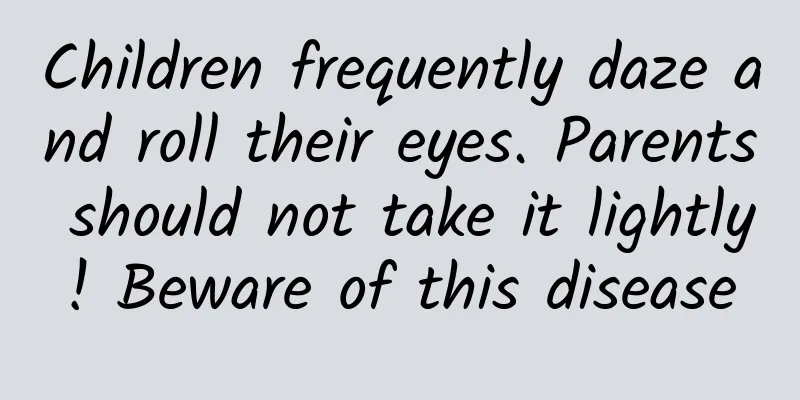Children frequently daze and roll their eyes. Parents should not take it lightly! Beware of this disease

|
Xiaoxin (pseudonym), a 7-year-old girl from Loudi, began to "roll her eyes" (blinking frequently and then looking upwards, described by her parents as rolling her eyes) half a year ago. Her parents took her to the ophthalmology department of a local hospital, where she was diagnosed with "conjunctivitis". There was no significant improvement after taking ophthalmic-related drugs. Later, Xiaoxin's parents observed that Xiaoxin had a slight head tilt backwards, and sometimes her head or hands shook involuntarily. They went to the local hospital for examination and were diagnosed with a possible "tic disorder". The relevant treatment was ineffective. In order to further clarify the diagnosis and treatment, Xiaoxin came to the Epilepsy Center of Hunan Provincial Second People's Hospital (Provincial Brain Hospital) for treatment. Chief physician Li Zhenguang saw Xiaoxin. After detailed questioning and examination, he found that Xiaoxin also had symptoms of photophobia, frequent distraction during the day, and sometimes short-term loss of consciousness (for example, she would suddenly be distracted when doing homework or holding chopsticks, and return to normal after a few seconds). The head magnetic resonance imaging was completed to exclude intracranial lesions, and blood and urine screening was performed to exclude abnormalities in metabolic diseases. At the same time, long-term video EEG monitoring was also performed. The video EEG indeed found abnormalities: the flash stimulation test induced Xiaoxin to be stunned and have rapid eyelid twitching attacks. At the same time, VEEG (video EEG) captured the widespread 3Hz spike-slow complex wave discharge in all leads, and the electromyography electrodes also showed synchronous electromyography discharge. Finally, after analyzing the clinical manifestations and video EEG monitoring results, the truth about Xiaoxin's condition was finally revealed. It turned out that she suffered from "eyelid myoclonus with absence epilepsy (Jeavons syndrome)". After half a month of treatment with prescribed anti-epileptic drugs, the child's symptoms of dazedness and rolling eyes disappeared. Li Zhenguang, chief physician of the Epilepsy Center of Hunan Second People's Hospital (Provincial Brain Hospital), emphasized: Children like Xiaoxin are often seen in the outpatient clinic. Frequent "rolling eyes", dazed, and slight limb shaking are also some atypical manifestations of epileptic seizures. When visiting non-epilepsy specialists, it is easy to misdiagnose them as "conjunctivitis", "tic disorder", "hypocalcemic convulsions", "facial muscle or eyelid muscle spasm" and other diseases. Many parents also take it lightly and think that their children are naughty and blinking due to bad habits. In fact, the clinical manifestations of this type of patients are often frequent blinking with or without absence, and blinking more frequently under strong light stimulation, which seriously affects their studies and causes abnormal behaviors such as poor academic performance, hyperactivity, and bad temper. They cannot be clearly diagnosed in primary hospitals and there is no treatment effect. Perfect video EEG monitoring examination is the key to diagnosing the disease. It is not difficult to diagnose Jeavons syndrome based on medical history, clinical symptoms, eye closing sensitivity and video EEG records, combined with photosensitivity. Li Zhenguang, chief physician of the Epilepsy Center of Hunan Provincial Second People's Hospital (Provincial Brain Hospital), further explained: Jeavons syndrome, also known as eyelid myoclonus with or without absence, is a rare childhood-onset epilepsy syndrome. Clinically, it manifests as a triad of eyelid myoclonus with absence, photosensitivity, and eye closure-induced seizures or epileptiform discharges. It is a reflex, idiopathic, and generalized epilepsy syndrome. It is often misdiagnosed as hemifacial spasm or eye disease. Patients often delay seeking medical attention until a generalized tonic-clonic seizure (GTCS) occurs. Therefore, the misdiagnosis and missed diagnosis rates are high. The peak age is 6-8 years old, and it is more common in girls. After imaging examinations have ruled out organic brain diseases, video EEG examinations are also essential. During the test, it is especially important to cooperate with and complete induction tests such as hyperventilation and flash stimulation, which can greatly improve the positive rate of the test, help to distinguish epileptic and non-epileptic seizure events, and avoid unnecessary missed diagnosis and misdiagnosis.
(Edited by ZS) |
Recommend
How much does laparotomy for uterine fibroids cost?
Uterine fibroids is a common disease among women....
Women sleep hot and cold at night
Why do women feel hot and cold when they sleep? W...
How to remove stretch marks? Have you done this?
Stretch marks are left over from a woman's pr...
What to do if leucorrhea is yellow and has an odor during pregnancy
Pregnant women are a target that deserves careful...
IUD and curettage for prolonged menstruation
In daily life, some women may experience stomach ...
Where are the acupuncture points for breast enhancement massage?
Every woman wants to have full breasts, but many ...
CIRP: iPhone users’ replacement cycle is getting longer and longer, with 71% of users using their phones for more than 2 years
The latest report from CIRP, a research organizat...
What should I eat more if I have uterine fibroids?
Most uterine fibroids are generally benign tumors...
What is the reason for female leucorrhea accompanied by a small amount of blood?
Leucorrhea is generally colorless, transparent or...
Why do nipples itch during pregnancy?
During pregnancy, changes in a woman's body w...
Zhong Nanshan gives the latest analysis on the epidemic issues you are concerned about
Are domestic vaccines effective against the Delta...
Is it okay for women to drink beer?
Beer is generally brewed from grains, so it has a...
Can I soak my feet here?
Women can soak their feet during menstruation, be...
What tests should be done for the second child?
For many women, the process of pregnancy is usual...









